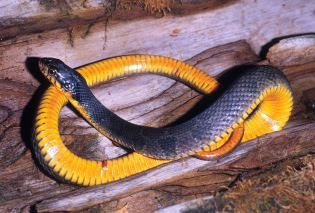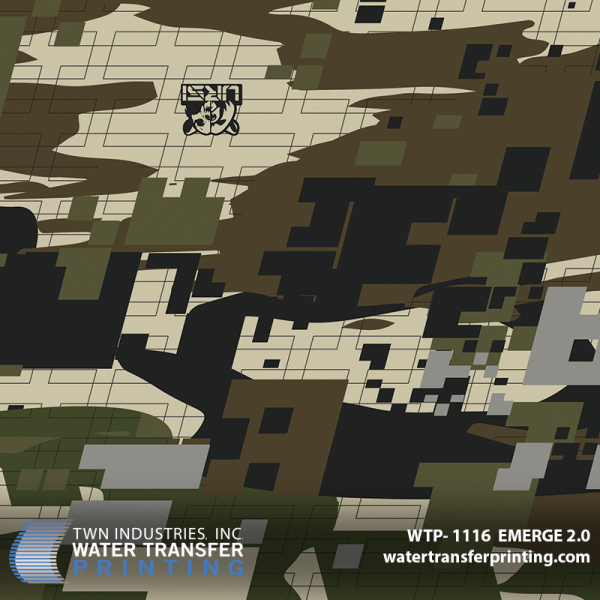Threatened and endangered species feature: the cautious copperbelly water snake
By Jillian Farkas, DNR Wildlife Division
 With binoculars in tow, I scouted the seemingly calm water in front of me. Slowly, and without a ripple, a sea monster-like head began to emerge from the water. With a duckweed disguise, the snake remained still, repeatedly flicking its tongue in my direction. To confirm identification of the species, I lunged towards the snake with long tongs, but it was just out of reach. Reacting to the threat of capture, the snake swiftly swam into the surrounding vegetation and escaped.
With binoculars in tow, I scouted the seemingly calm water in front of me. Slowly, and without a ripple, a sea monster-like head began to emerge from the water. With a duckweed disguise, the snake remained still, repeatedly flicking its tongue in my direction. To confirm identification of the species, I lunged towards the snake with long tongs, but it was just out of reach. Reacting to the threat of capture, the snake swiftly swam into the surrounding vegetation and escaped.
The copperbelly water snake is an exceptionally rare species in Michigan. These snakes are found in two distinct population segments in the United States – the north and south. The northern population remains federally listed as threatened, and its range includes southern Michigan, northwestern Ohio and northeastern Indiana. In Michigan, this species is listed as endangered and has only been documented at 13 sites in seven counties. However, recent surveys have revealed that the number of sites the species currently occupies has dwindled down to only four.
 Copperbelly water snakes are harmless, non-poisonous, relatively large, semi-aquatic snakes that are often witnessed basking in the sun where they can effortlessly escape into water if bothered. They tend to live near shrub wetlands, wooded floodplains and slow-moving rivers. A hungry copperbelly will hunt a variety of prey, including tadpoles, frogs, salamanders, insect larvae and crayfish. Adults are dark black or brown on the top, with a vibrant orange-red underside. These snakes also have labial (lip) scales that are tinted slightly orange-red with darkened edges. In Michigan, northern water snakes, Kirtland’s snakes, queen snakes and northern red-bellied snakes look similar to, and might be mistaken for, the copperbelly water snake.
Copperbelly water snakes are harmless, non-poisonous, relatively large, semi-aquatic snakes that are often witnessed basking in the sun where they can effortlessly escape into water if bothered. They tend to live near shrub wetlands, wooded floodplains and slow-moving rivers. A hungry copperbelly will hunt a variety of prey, including tadpoles, frogs, salamanders, insect larvae and crayfish. Adults are dark black or brown on the top, with a vibrant orange-red underside. These snakes also have labial (lip) scales that are tinted slightly orange-red with darkened edges. In Michigan, northern water snakes, Kirtland’s snakes, queen snakes and northern red-bellied snakes look similar to, and might be mistaken for, the copperbelly water snake.
The decline of copperbelly water snakes to a few hundred individuals in the state is mainly due to loss of habitat through flood control, roads, conversion of wetlands to agriculture and other development that has altered the wetlands these snakes depend on. In addition to habitat loss, copperbellies are sometimes illegally collected to be sold in the pet trade because of their rarity and distinctively colored undersides. By conserving copperbelly water snakes, we conserve ecosystems that support many plant and animal species.
Keeping copperbelly water snakes as part of Michigan’s natural heritage may seem unimportant to many people, but the complete loss of a species is an indication that ecosystems are not functioning as they should. In the case of wetlands where copperbelly water snakes live, the loss of flood storage, groundwater recharge and clean streams that flow steadily are impacts people might feel if there is not sufficient habitat for the snakes.
I will never know if that seeming sea monster was in fact a copperbelly water snake, but if you have the chance to spot this rare Michigan creature, consider yourself fortunate!
Any sightings of adult copperbelly water snakes should be reported to copperbelly@fws.gov.
There are several easy ways you can help conserve this unique snake:
- Buy a wildlife habitat license plate.
- Buy a Living Resources wildlife patch.
- Simply make a tax-deductible donation.
- Learn about creating wildlife habitat on your property.
- Learn more about the copperbelly water snake and Michigan’s other snakes.
With increased funding to the Nongame Wildlife Fund, we can increase our efforts to protect and manage habitats for copperbelly water snakes.
For more information on Michigan’s threatened and endangered species and the 40th-anniversary celebration, visit www.michigan.gov/wildlife.





